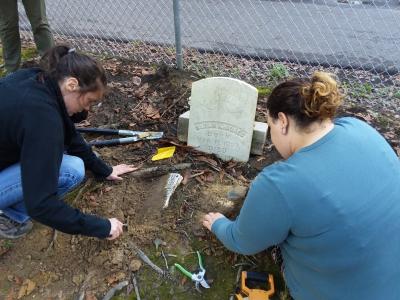Anthropology Students Participate in Archaeology Project at Hattiesburg Cemetery
Thu, 02/14/2019 - 04:36pm

A small abandoned cemetery in east Hattiesburg is easily overlooked, but those buried
within its boundaries are part of the history of the earliest years of the city. The
Anthropology Program in The University of Southern Mississippi's (USM) School of Social
Science and Global Studies, in conjunction with the city's Department of Parks and
Recreation is now working to help tell its story.
Located two blocks east of Main Street, the Eighth Street cemetery for decades was
covered in trees and overgrown weeds. A few years ago, it came under the control of
the city, which cleared the property and reset the three headstones still present
belonging to Sarah A. Jones (1838-1888), Victor Jones (d. 1915), and Leon Jones (no
dates), the latter two veterans of the Spanish-American War, according to their headstone
inscriptions. Perhaps most intriguing, however, was a large grave outlined by a brick
border about eight inches high, which is set apart from the other burials.
This past fall, Dr. Marie Danforth and Dr. Nate Meissner, professors in the Anthropology Program, along with a cadre of graduate and undergraduate anthropology students, began to preliminarily map the cemetery as well as research those who also might be interred there. A look at the census records for the city in the late 1800s revealed the three named represented a mother and her sons. Other records also indicated the first mayor of Hattiesburg (1884-85), O.H.P. (Oliver Hazard Perry) Jones, and his wife, Mary Ann Burkett Jones, were once interred there as well, although moved to Oaklawn Cemetery in 1962. Sarah and her sons were the family of O.H.P.'s brother, Dr. William E. Jones.
Armed with long measuring tapes, shovels, probes, and trowels, the anthropologists made a preliminary map of the small cemetery in November 2018. A number of depressions in two north-south rows were evident, but the overall soft texture of the soil made demarcation of individual graves challenging. Assuming interments were oriented with heads to the west, a very shallow trench was dug where the headstones likely would have been placed. Only one additional stone was uncovered, but when the fragmented pieces were put together, it read “Dr. W.E. Jones.”
The next step involved employment of ground penetrating radar (GPR) analysis, which can detect differences in subsurface texture such as the presence of a coffin, which took place in mid-December. USM anthropology professor and archaeologist Dr. Ed Jackson began by making a much more accurate of the cemetery using GPS technology, which will then be used to coordinate with the GPR data. Dr. David Holt, a USM geographer, along with Dr. Alyson Brink, a USM geologist, and several graduate students from the Gulf Park campus traveled to Hattiesburg to conduct the work. Using equipment about the size of a large push lawn mower, they identified about six likely graves and several more potential graves. The soil below the brick feature, however, did not show any differences from the surrounding area, suggesting that if anyone ever had been buried within, they were no longer present, which suggests it might be where O.H.P. Jones was originally interred.
USM Anthropology graduate students J.T. Lewis of Gonzales, Louisiana and Amy Hair
of Macomb, Michigan participated in the project, and cited its multiple benefits for
students and the community.
“Investigating the 8th Street Cemetery allowed me to uncover information about a family
vital to the development of early Hattiesburg, and the archival research the project
required allowed me to develop skills that can be used in preserving historic sites,”
Lewis said. “I believe it's important that USM and the city continue to work together
on projects like these, so the early people of Hattiesburg aren't forgotten and are
remembered for roles they each played in developing current-day Hattiesburg."
“Our work at the 8th Street Cemetery has been a great opportunity to learn about the
early days of Hattiesburg through archaeology, and allowed me and other students to
improve our archaeological field skills,” said Amy
Hair's primary research role in the project included creation of 3D models of the grave stones located at the site. She said the experience helped improve her archaeological skills.
“These (3D) models will allow us to revisit the markers whenever necessary, but also help members of the Hattiesburg community learn and interact with pieces of the town's cultural heritage,” she said.
The anthropologists continue their work on the cemetery, which includes investigating the life stories of those buried there and setting up a website with the information gained from the project.
“Cemeteries can be incredibly illuminating about local history,” said Dr. Danforth. “When we began researching the 8th Street Cemetery, we never expected that those buried there would be involved with the very establishment of Hattiesburg. It's been fascinating to learn about the family of the first mayor of the city, and we believe the community will feel the same way.”
This research team's future plans include mapping Mount Olive Cemetery, the first African-American cemetery in Hattiesburg that is located off William Carey Parkway, where attempts will also be made to identify unmarked graves. Interviews will also be conducted with the descendant community about their memories of the cemetery.
For information about the USM Anthropology Program, visit https://www.usm.edu/anthropology-sociology.